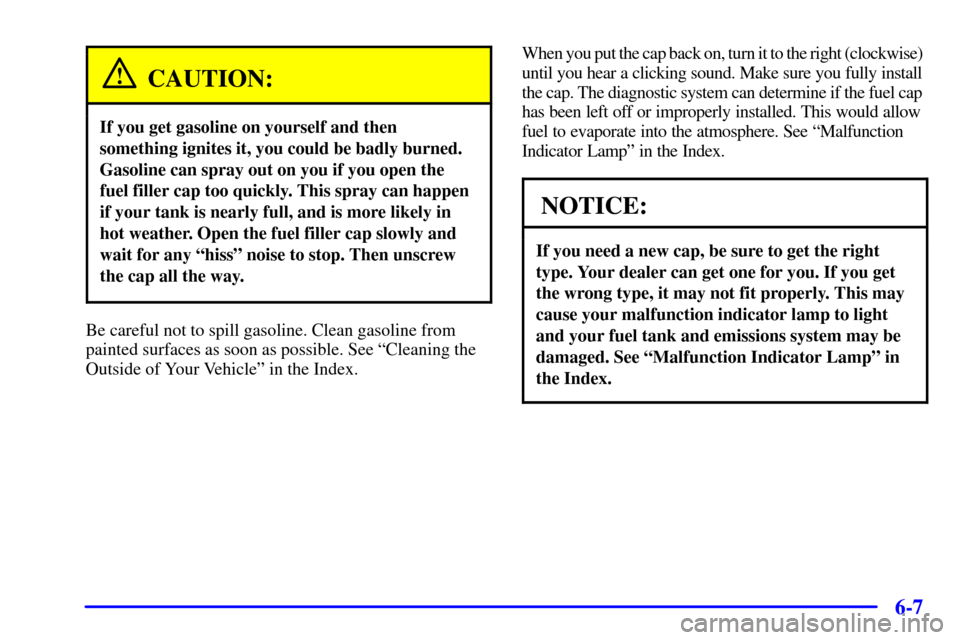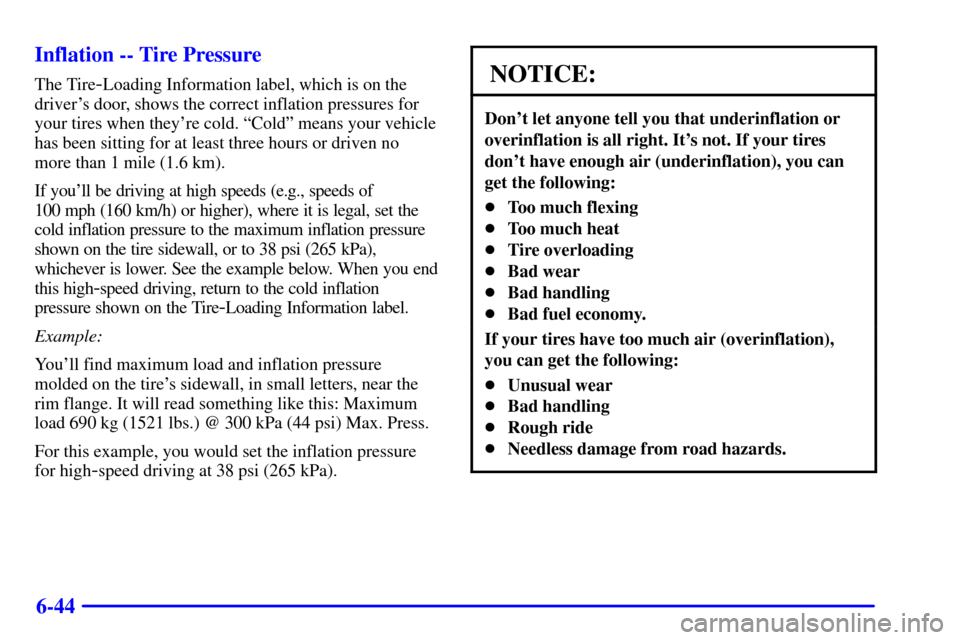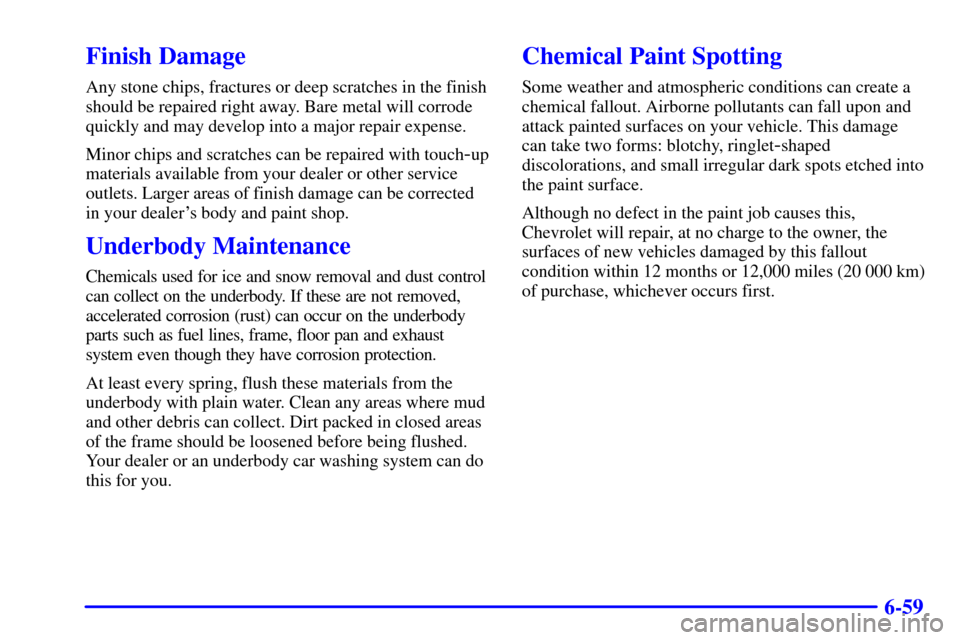Page 261 of 363

6-7
CAUTION:
If you get gasoline on yourself and then
something ignites it, you could be badly burned.
Gasoline can spray out on you if you open the
fuel filler cap too quickly. This spray can happen
if your tank is nearly full, and is more likely in
hot weather. Open the fuel filler cap slowly and
wait for any ªhissº noise to stop. Then unscrew
the cap all the way.
Be careful not to spill gasoline. Clean gasoline from
painted surfaces as soon as possible. See ªCleaning the
Outside of Your Vehicleº in the Index.When you put the cap back on, turn it to the right (clockwise)
until you hear a clicking sound. Make sure you fully install
the cap. The diagnostic system can determine if the fuel cap
has been left off or improperly installed. This would allow
fuel to evaporate into the atmosphere. See ªMalfunction
Indicator Lampº in the Index.
NOTICE:
If you need a new cap, be sure to get the right
type. Your dealer can get one for you. If you get
the wrong type, it may not fit properly. This may
cause your malfunction indicator lamp to light
and your fuel tank and emissions system may be
damaged. See ªMalfunction Indicator Lampº in
the Index.
Page 262 of 363

6-8
Filling a Portable Fuel Container
CAUTION:
Never fill a portable fuel container while it is in
your vehicle. Static electricity discharge from the
container can ignite the gasoline vapor. You can
be badly burned and your vehicle damaged if this
occurs. To help avoid injury to you and others:
�Dispense gasoline only into
approved containers.
�Do not fill a container while it is inside a
vehicle, in a vehicle's trunk, pickup bed or
on any surface other than the ground.
�Bring the fill nozzle in contact with the
inside of the fill opening before operating
the nozzle. Contact should be maintained
until the filling is complete.
�Don't smoke while pumping gasoline.
Checking Things Under the Hood
CAUTION:
An electric fan under the hood can start up and
injure you even when the engine is not running.
Keep hands, clothing and tools away from any
underhood electric fan.
CAUTION:
Things that burn can get on hot engine parts and
start a fire. These include liquids like gasoline,
oil, coolant, brake fluid, windshield washer and
other fluids, and plastic or rubber. You or others
could be burned. Be careful not to drop or spill
things that will burn onto a hot engine.
Page 266 of 363
6-12
Engine Oil
If the LOW OIL light
appears on the instrument
panel, it means you need to
check your engine oil level
right away. For more
information, see ªLow Oil
Lightº in the Index.
You should check your engine oil level regularly; this is
an added reminder.
Checking Engine Oil
It's a good idea to check your engine oil every time you
get fuel. In order to get an accurate reading, the oil must
be warm and the vehicle must be on level ground.The engine oil dipstick handle is the yellow loop located
near the back of the engine. See ªEngine Compartment
Overviewº in the Index for more information on location.
Do not check the 5.7L V8 engine oil level after the engine
has been sitting overnight. A higher than normal reading
might be obtained. Check oil level with the oil warm.
Page 298 of 363

6-44 Inflation -- Tire Pressure
The Tire-Loading Information label, which is on the
driver's door, shows the correct inflation pressures for
your tires when they're cold. ªColdº means your vehicle
has been sitting for at least three hours or driven no
more than 1 mile (1.6 km).
If you'll be driving at high speeds (e.g., speeds of
100 mph (160 km/h) or higher), where it is legal, set the
cold inflation pressure to the maximum inflation pressure
shown on the tire sidewall, or to 38 psi (265 kPa),
whichever is lower. See the example below. When you end
this high
-speed driving, return to the cold inflation
pressure shown on the Tire
-Loading Information label.
Example:
You'll find maximum load and inflation pressure
molded on the tire's sidewall, in small letters, near the
rim flange. It will read something like this: Maximum
load 690 kg (1521 lbs.) @ 300 kPa (44 psi) Max. Press.
For this example, you would set the inflation pressure
for high
-speed driving at 38 psi (265 kPa).
NOTICE:
Don't let anyone tell you that underinflation or
overinflation is all right. It's not. If your tires
don't have enough air (underinflation), you can
get the following:
�Too much flexing
�Too much heat
�Tire overloading
�Bad wear
�Bad handling
�Bad fuel economy.
If your tires have too much air (overinflation),
you can get the following:
�Unusual wear
�Bad handling
�Rough ride
�Needless damage from road hazards.
Page 313 of 363

6-59
Finish Damage
Any stone chips, fractures or deep scratches in the finish
should be repaired right away. Bare metal will corrode
quickly and may develop into a major repair expense.
Minor chips and scratches can be repaired with touch
-up
materials available from your dealer or other service
outlets. Larger areas of finish damage can be corrected
in your dealer's body and paint shop.
Underbody Maintenance
Chemicals used for ice and snow removal and dust control
can collect on the underbody. If these are not removed,
accelerated corrosion (rust) can occur on the underbody
parts such as fuel lines, frame, floor pan and exhaust
system even though they have corrosion protection.
At least every spring, flush these materials from the
underbody with plain water. Clean any areas where mud
and other debris can collect. Dirt packed in closed areas
of the frame should be loosened before being flushed.
Your dealer or an underbody car washing system can do
this for you.
Chemical Paint Spotting
Some weather and atmospheric conditions can create a
chemical fallout. Airborne pollutants can fall upon and
attack painted surfaces on your vehicle. This damage
can take two forms: blotchy, ringlet
-shaped
discolorations, and small irregular dark spots etched into
the paint surface.
Although no defect in the paint job causes this,
Chevrolet will repair, at no charge to the owner, the
surfaces of new vehicles damaged by this fallout
condition within 12 months or 12,000 miles (20 000 km)
of purchase, whichever occurs first.
Page 320 of 363
6-66
Underhood Electrical Center
Fuse and Relay Center 1
Fuse Usage
ABS BAT SOL Anti
-Lock Brake System
TCS BAT Traction Control System (ASR)
and ETC
COOL FAN Cooling Fan Control
PCM BAT Powertrain Control
Module (PCM)Fuse Usage
FUEL PUMP Fuel Pump
AIR PUMP Air Pump Relay and Bleed Valve
LH HDLP DR Left Headlamp Door and Module
RH HDLP DR Right Headlamp Door and Module
HORN Horn Relay
ABS BAT
-1 Anti-Lock Brake System Module
H/L DR HORN Horn and Headlamp Doors
ABS BAT
-2 Anti-Lock Brake and Traction
Control System (ASR)
COOL FAN Cooling Fan Relays
Relay Description
FOG LAMP Fog Lamps
HORN Horn
FAN #3 Cooling Fans
FAN #2 Cooling Fans
FAN #1 Cooling Fans
Page 321 of 363
6-67
Fuse and Relay Center 2
Fuse Usage
INJ
-2 Fuel Injectors (Not Used for V6)
(LH Injectors for V8 and
Ignition Module)
INJ
-1 Fuel Injectors (All for V6)
(RH Injectors for V8 and
Ignition Module)
ENG SEN Mass Air Flow, Heated Oxygen
Sensor, Skip Shift Solenoid
(V8 Only), Reverse Lockout
Solenoid, Brake SwitchFuse Usage
STRTR Powertrain Control Module
(PCM) and Clutch Pedal Switch
ABS IGN Anti
-Lock Brake System Module
PCM IGN Powertrain Control
Module (PCM)
ETC Electronic Throttle
Control (V6 Only)
ENG CTRL Ignition Module (V6 Only),
Automatic Transmission and
Charcoal Canister Purge Solenoid
A/C CRUISE Air Conditioning Compressor
Relay, Cruise Control Switches
and Module
ENG CTRL Engine Controls, Fuel Pump,
Powertrain Control Module
(PCM), A.I.R. and Cooling Fans
I/P
-1 HVAC Blower Control and Relay
IGN Ignition Switch, Relay and Starter
Enable Relay
I/P
-2 Instrument Panel Fuse Center
Page 322 of 363
6-68
Relay Description
Blank Not Used
AIR PUMP Air Pump
A/C COMP Air Conditioning Compressor
FUEL PUMP Fuel Pump
STARTER Starter
IGN Engine Controls, Cruise Control,
Air ConditioningReplacement Bulbs
Back-Up3155 . . . . . . . . . . . . . . . . . . . . . . . . . . . . . .
Center High
-Mounted Stoplamp921 . . . . . . . . . . .
Front Parking and Turn Signal3157 K . . . . . . . . .
Headlamps
Low Beam 9006. . . . . . . . . . . . . . . . . . . . . . . . . . . .
High Beam 9005. . . . . . . . . . . . . . . . . . . . . . . . . . .
Sidemarker Lamps194 . . . . . . . . . . . . . . . . . . . . . .
Taillamps Only194 . . . . . . . . . . . . . . . . . . . . . . . . . .
Tail/Stop/Turn Lamps3057 . . . . . . . . . . . . . . . . . . .